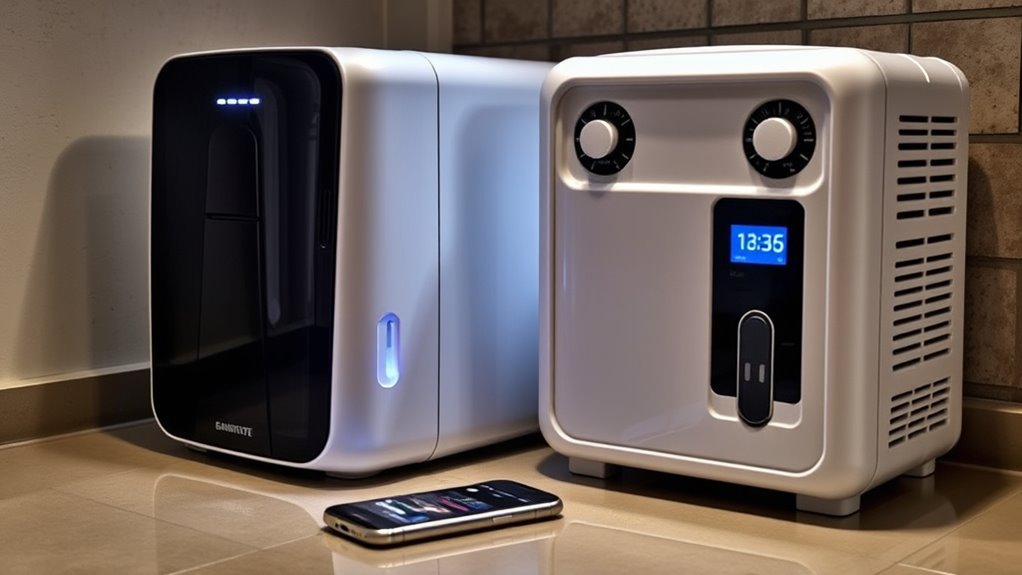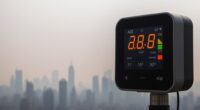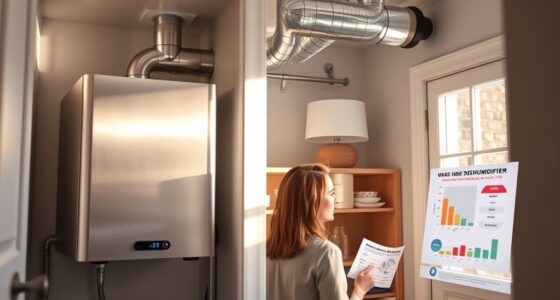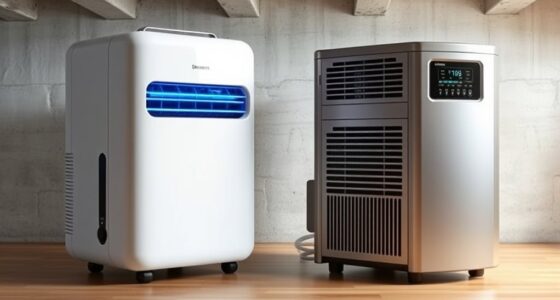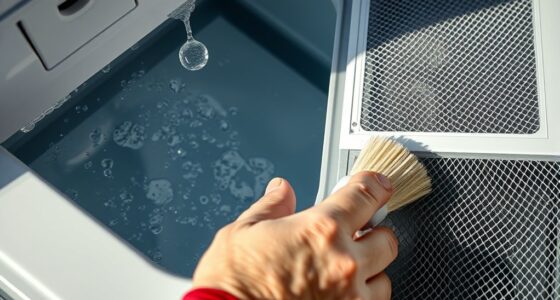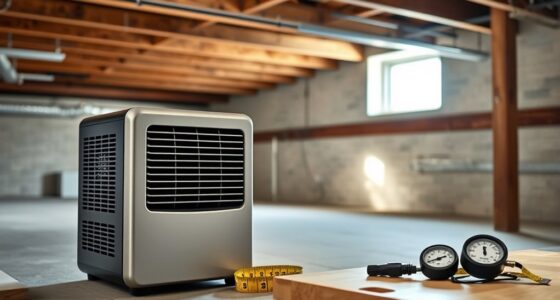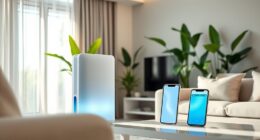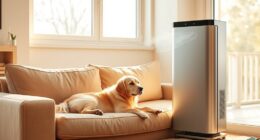If you’re considering a dehumidifier, using an app with a smart model can give you remote control, real-time humidity updates, and customized settings, making it more convenient. Manual units rely on basic controls and don’t connect to devices, which may suit simpler needs. If you want more ease, flexibility, and monitoring, smart dehumidifiers are worth it. Keep exploring to find out how each option fits your home and lifestyle.
Key Takeaways
- Smart dehumidifiers require an app for remote control, monitoring, and adjusting settings, unlike manual models which use physical controls.
- If you value convenience and real-time data, an app-enabled smart dehumidifier is beneficial; manual units don’t need an app.
- Manual dehumidifiers are suitable for users who prefer simple setup without needing digital connectivity or smartphone control.
- The decision depends on your tech comfort level—if you want automation and remote features, an app is essential.
- Cost, energy savings, and aesthetic preferences also influence whether a smart dehumidifier with an app is the right choice for you.
How Smart Dehumidifiers Enhance Convenience and Control
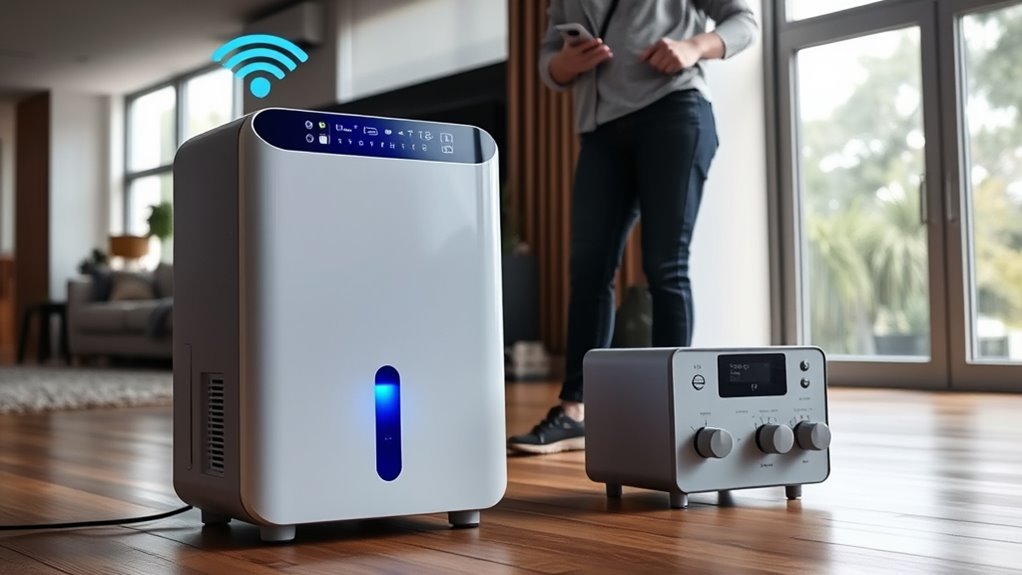
Smart dehumidifiers make managing indoor humidity much easier by providing advanced features that give you greater control. One standout benefit is their vintage design, which adds a charming aesthetic appeal to your space. Unlike bulky, utilitarian models, these units blend seamlessly into your home decor, making them both functional and stylish. You can customize settings remotely through an app, so you don’t have to get up or manually adjust the device. This convenience means you’ll always have ideal humidity levels without hassle. Plus, the vintage-inspired design offers a nostalgic touch that elevates your room’s look. With smart technology and aesthetic appeal working in harmony, you gain precise control over your environment while enhancing your home’s overall style. Additionally, some models incorporate preppy dog names to add a touch of personality and charm to your space.
Cost Comparison: Smart vs. Manual Models
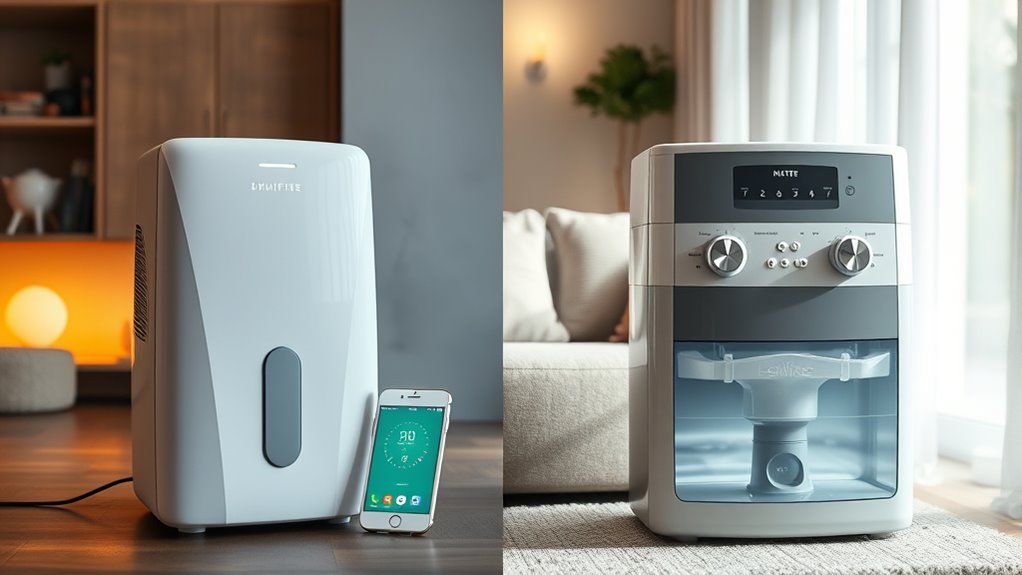
While smart dehumidifiers often come with a higher upfront cost, they can save you money over time through energy-efficient operation and remote monitoring features. These models typically consume less energy because they adjust their operation based on real-time humidity levels, reducing unnecessary run times. Additionally, their high refresh rates and precise control help optimize performance and further reduce energy consumption. However, the initial investment can be steeper, especially when considering installation complexity. Smart units may require Wi-Fi setup and app integration, which might be more involved than installing manual models. Manual dehumidifiers usually have lower purchase prices and simpler installation, but they lack the energy-saving capabilities of their smart counterparts. Over time, energy savings and convenience can offset the initial costs of smart models, making them a potentially more cost-effective choice for long-term use.
Features and Functionality: What Each Type Offers
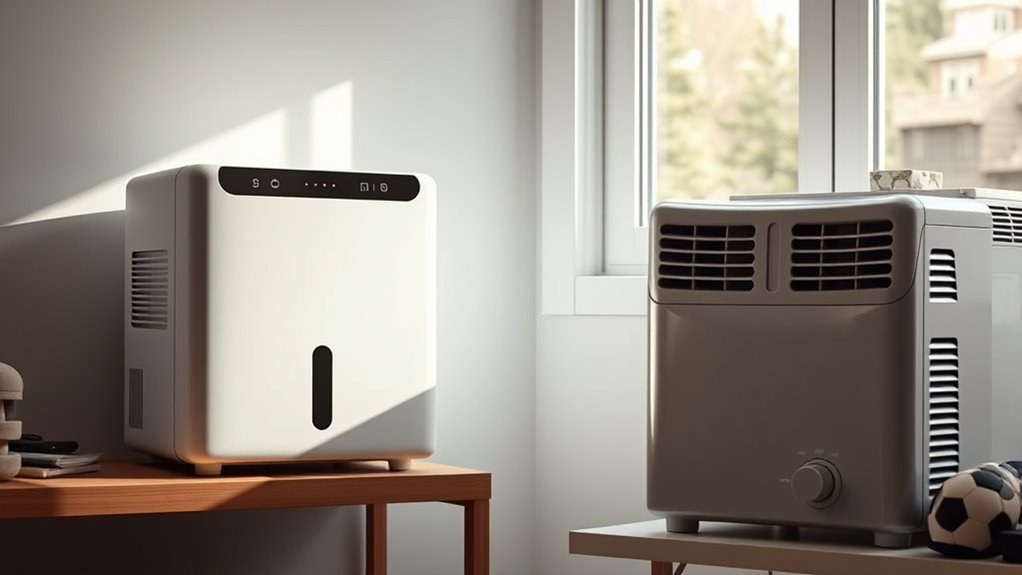
Manual dehumidifiers offer straightforward operation with basic features like adjustable dials or manual controls to set your desired humidity level. They typically have simple user interfaces, such as knobs or switches, making them easy to operate without technical knowledge. These models usually lack connectivity options, so you won’t control them remotely. Instead, they focus on core functionality like moisture removal. In contrast, smart dehumidifiers often feature digital displays, smartphone apps, and Wi-Fi or Bluetooth connectivity options, allowing remote adjustments and alerts. Here’s what each type offers: 1. User interface: basic controls vs. digital touchscreens 2. Connectivity options: none vs. Wi-Fi/Bluetooth 3. Customization: manual settings vs. app-based controls 4. Monitoring: local indicators vs. remote notifications. Some models can also be integrated into smart home systems, enhancing convenience and control.
Ease of Use and Setup for Different Users
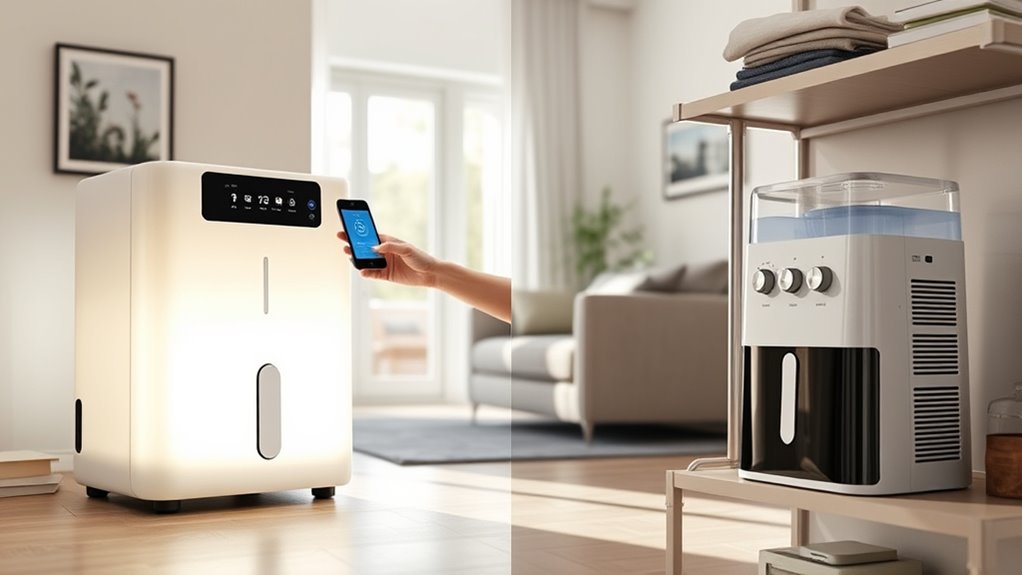
Ease of use and setup can vary considerably depending on your familiarity with technology. If you’re comfortable with digital devices, a smart dehumidifier’s user interface might seem straightforward, often featuring touch screens or app controls that simplify setup. The installation process for a smart model may involve downloading an app, connecting via Wi-Fi, and syncing your device, which can be quick but slightly complex for first-timers. Conversely, manual dehumidifiers typically have a simple setup—just plug in, position, and turn on—making them very user-friendly for those less tech-savvy. While manual models usually lack a digital interface, they often require minimal effort. Your comfort with technology determines whether you prefer the streamlined, app-based setup of smart units or the straightforward, no-fuss installation of manual dehumidifiers. Additionally, ease of use can be enhanced by features like clear instructions and intuitive controls, which are especially beneficial for seniors or individuals less familiar with modern technology.
Maintenance and Monitoring: Traditional vs. App-Connected Devices
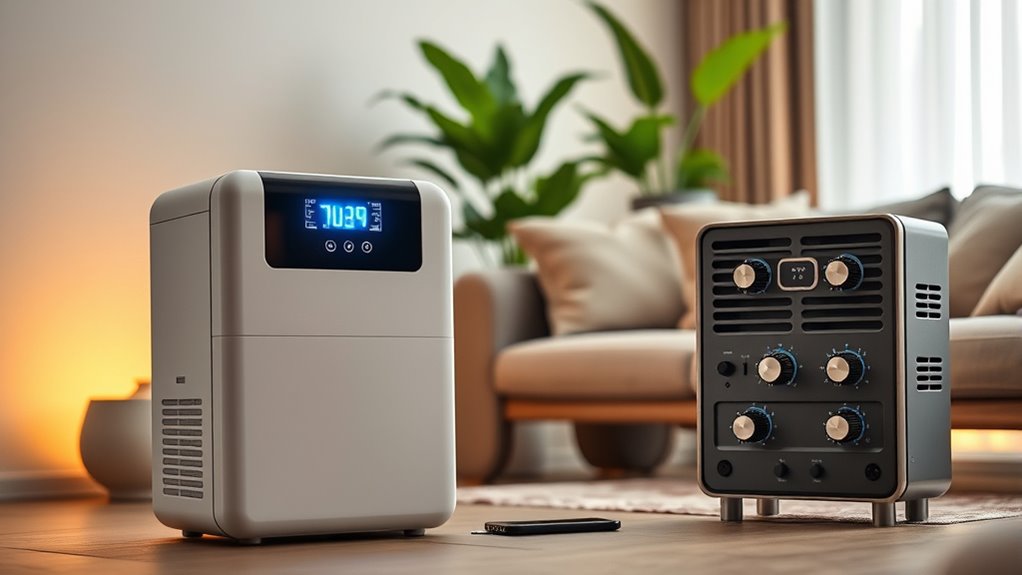
With manual dehumidifiers, you need to check the water level and filter regularly to keep them running smoothly. App-connected devices allow you to monitor humidity levels in real time from your phone, so you can stay on top of maintenance effortlessly. This makes managing your dehumidifier more convenient and responsive to changing conditions. Additionally, some smart dehumidifiers incorporate hygrometer technology to provide more precise humidity control.
Manual Checks Required
While traditional dehumidifiers require you to physically check and empty their water tanks regularly, app-connected models simplify this process by providing real-time alerts and remote monitoring. However, manual checks are still necessary for proper operation. You need to:
- Inspect water tanks regularly to prevent overflow and manually drain when full.
- Calibrate sensors periodically to ensure accurate humidity readings.
- Verify sensor calibration to maintain ideal performance.
- Check for mold or debris that could interfere with the dehumidifier’s efficiency.
- Regularly review and maintain caffeine content in your devices to ensure optimal performance and safety.
These tasks ensure your device functions correctly and prevent issues like mold growth. Manual draining, though straightforward, is essential to avoid water damage. Proper maintenance helps extend your dehumidifier’s lifespan and keeps your space dry.
Real-Time Monitoring Possible
Traditional dehumidifiers require you to manually check their status, meaning you need to physically inspect the unit or water tank regularly to assess humidity levels and water collection. This process can be time-consuming and less efficient, often leading to energy waste if the device runs unnecessarily. In contrast, app-connected dehumidifiers offer real-time monitoring, allowing you to track humidity levels remotely. This enhances user engagement by providing instant alerts and control at your fingertips. With real-time data, you can optimize operation times, leading to better energy savings. Plus, you avoid the hassle of frequent manual checks, ensuring your space stays comfortable without wasting power. Additionally, tuning Hyundai models demonstrates how precise adjustments can improve overall vehicle efficiency, similar to how real-time monitoring optimizes dehumidifier performance. Ultimately, app-connected devices make maintenance easier and more precise, saving you time and money.
Making the Right Choice for Your Home Environment
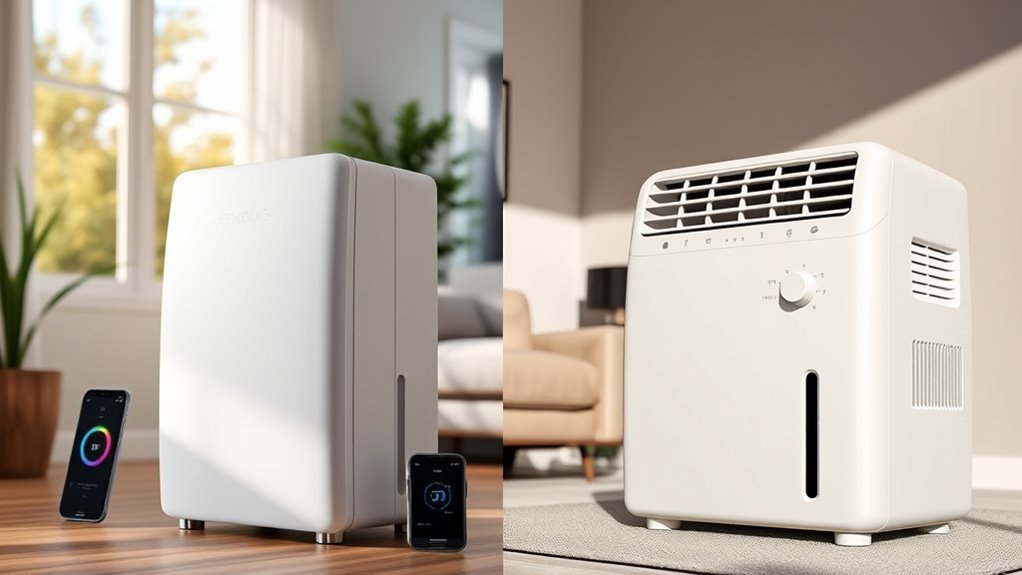
When choosing a dehumidifier, consider how convenient and accessible it needs to be for your daily routine. Think about monitoring and control features that suit your tech comfort level, and weigh their impact on your budget and energy use. Making the right choice depends on balancing these factors to fit your home’s environment and your lifestyle.
Convenience and Accessibility
Are you looking for a dehumidifier that fits seamlessly into your daily routine? Convenience and accessibility are key when choosing between smart and manual models. Smart dehumidifiers often come with apps, allowing remote control, scheduling, and real-time alerts. Manual units, however, require physical adjustments, which can be less practical. Consider these aspects:
- Ease of use: Smart models offer one-touch control via your phone.
- Styling options: Both types come in various styles, but smart units often feature sleek designs.
- Color choices: Select a device that matches your decor for a cohesive look.
- Placement flexibility: Smart dehumidifiers typically have better accessibility through app control, making placement easier.
- Monitoring features: Smart dehumidifiers can provide real-time data on humidity levels, enhancing your ability to maintain optimal conditions.
Choosing based on convenience ensures your home environment stays comfortable without hassle.
Monitoring and Control Features
Monitoring and control features play a vital role in ensuring your dehumidifier effectively maintains the ideal humidity levels in your home. With smart home technology, you can easily track humidity levels in real-time through apps or built-in displays. Advanced humidity sensors provide precise readings, allowing your dehumidifier to automatically adjust its operation for maximum comfort. Smart models often include features like remote control and customizable settings, giving you more control without needing to be physically near the device. Manual dehumidifiers rely solely on basic controls, which require you to monitor and adjust settings yourself. If maintaining consistent humidity is a priority, investing in a dehumidifier with advanced monitoring and control features can make managing your home environment much easier and more efficient. Incorporating humidity management systems can further optimize indoor air quality and comfort.
Cost and Energy Efficiency
Choosing between smart and manual dehumidifiers often hinges on their cost and energy efficiency, which can considerably impact your long-term savings. Smart units typically have higher upfront costs but offer better energy savings through automated adjustments and remote control. Manual dehumidifiers are cheaper initially but may consume more energy if operated inefficiently. Consider these points:
- Smart dehumidifiers optimize energy use, reducing ongoing costs.
- Manual units may require more manual adjustments, increasing energy waste.
- Smart models often feature energy-saving modes and scheduling options.
- Manual dehumidifiers are generally more cost-effective upfront but less efficient long-term.
- Additionally, smart dehumidifiers can provide real-time feedback on humidity levels, helping you maintain optimal conditions more precisely through precise control.
Your choice depends on balancing initial expenses with ongoing energy savings and overall cost effectiveness for your home environment.
Frequently Asked Questions
Can Smart Dehumidifiers Be Integrated With Home Automation Systems?
Yes, smart dehumidifiers can be integrated with your home automation systems. You can control them with voice commands and enjoy remote monitoring from your smartphone or tablet. This integration allows you to easily adjust settings, track humidity levels, and automate operation based on your preferences. With smart dehumidifiers, you get more convenience and control, making it easier to maintain a comfortable and healthy home environment.
Do Smart Dehumidifiers Require a Stable Wi-Fi Connection to Function?
Imagine your smart dehumidifier as a skilled sailor. To navigate smoothly, it needs a steady breeze—your Wi-Fi connection. If Wi-Fi stability or network reliability falters, your device can’t communicate properly, causing it to stall or malfunction. So, yes, a stable Wi-Fi connection is essential for peak smart dehumidifier performance. Without it, you risk losing control and the benefits of smart features.
Are There Privacy Concerns With App-Connected Dehumidifiers Collecting Data?
When using app-connected dehumidifiers, you might worry about data security and user privacy. These devices collect usage data, which could be vulnerable if not properly protected. Always check the manufacturer’s privacy policy and make sure they use encryption and secure servers. You have control over your personal information, so choose brands that prioritize data security and transparency to keep your user privacy protected.
How Does App Control Impact the Energy Efficiency of Dehumidifiers?
Wondering how app control impacts energy efficiency? With intuitive app integration, you can precisely schedule, monitor, and modify your dehumidifier’s operation, promoting significant energy savings. This technology boosts user convenience, allowing you to optimize performance from anywhere. By fine-tuning settings and avoiding unnecessary operation, app control minimizes waste, maximizes efficiency, and guarantees your space stays comfortable while conserving power. It’s a smart solution for smarter, more efficient dehumidification.
Can Manual Dehumidifiers Be Upgraded With Smart Technology Later?
You can often upgrade a manual dehumidifier with retrofit options to add smart technology later. Many models support manual upgrades through compatible smart plugs, remote sensors, or external controls, allowing you to monitor and adjust humidity remotely. However, check your dehumidifier’s compatibility before attempting a manual upgrade, as not all units support retrofit options. This way, you can enhance functionality without replacing your existing device.
Conclusion
Choosing between a smart and manual dehumidifier is like picking the right tool for a craft—you want precision and convenience or simplicity and reliability. If you crave effortless control and real-time monitoring, a smart model is your compass. But if you prefer straightforward operation without the tech fuss, a manual unit still gets the job done. Ultimately, it’s about matching the device to your lifestyle, creating a sanctuary where humidity stays perfectly in tune.
